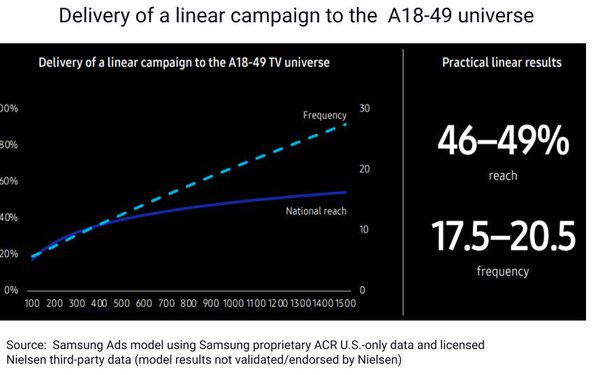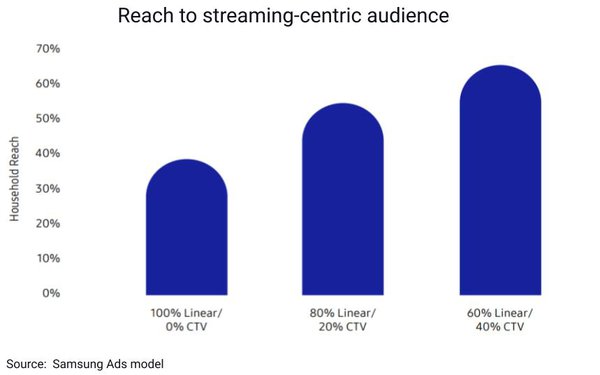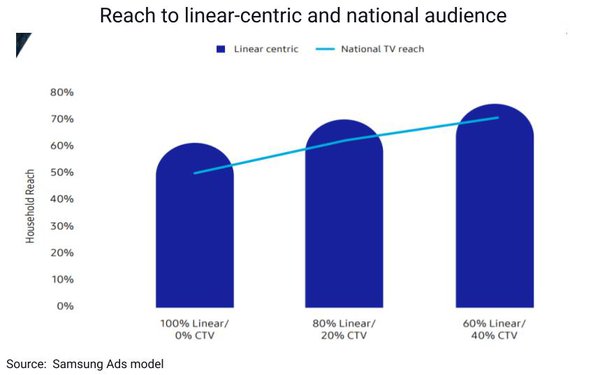Commentary
Samsung: New Data Bolster Case For CTV Investment, AVOD View Time Surpasses SVOD
- by Karlene Lukovitz @KLmarketdaily, September 20, 2022

In July 2021, Samsung Ads released a study that concluded that TV advertisers generally should be allocating about 40% of media budgets to ad-supported streaming to minimize overexposure to linear-only homes and achieve optimal advertising parity in homes that stream.
Now, the smart TV manufacturer’s advertising arm has completed a follow-up study that bolsters and expands on the original results.
Moreover, as a backdrop, Samsung reports that, at least among its U.S. smart TV users, viewing time for ad-supported video-on-demand (slightly) surpassed viewing time for subscription VOD in this year's first quarter (chart above). It also reports that 95% of its smart TV viewers stream content, 75% spend most of their viewing time with streaming, and three in four watch ad-supported streaming content.
The fragmentation of viewing, the continued growth of broadband-only homes, and the ongoing decline in cable subscribers are "making it impossible" to reach U.S. households using only national broadcast and cable, the report sums up.
The second study again used ACR-based first-party data on viewership across linear TV, OTT and gaming environments from Samsung smart TV owners, combined with third-party Nielsen data. A model was created to measure impression (GRP) delivery of 21 national brand TV campaigns against viewers that spend more time watching linear TV than streaming through CTV (linear-centric audiences) and streaming-centric audiences.
Various scenarios were run to find the point at which linear-centric reach peaks and begins to diminish. Budgets were then reallocated to follow a 40% allocation to CTV — what Samsung dubs “the Rule of 40” — and national TV reach across both linear- and streaming-centric audiences was measured.
The study found that the maximum possible reach for a heavy linear schedule is now just 60% of adults 18 to 49.
Across the 21 national campaigns analyzed, the reach curve of linear TV plateaued at just over 50% after 1,050 GRPs or 1.35 billion impressions.
However, the practical reach of linear TV — the point at which reach is maximized before further spend becomes wasted frequency — is significantly lower: under 50% of national reach.
Because the half of the TV audience that is linear-centric consumes 87% of a linear campaign’s impressions, linear TV oversaturates that audience and frequency becomes too great.
As such, the practical reach and frequency of linear TV to the A18–49 audience is about 800 GRPs, or 1 billion impressions. Beyond this level, additional spend increases frequency among those already reached while additional reach slows significantly.

Allocating 40% of linear budgets to CTV balances frequency between linear- and streaming-centric audiences, and also increases reach to linear viewers by adapting to their streaming behavior, according to the report.
“Because of the change in viewing
behavior, shifting linear spend to CTV increases national TV reach without the need to add budget to a media plan, regardless of spend level,” it concludes.





Again it seems that "homes" and "viewers" are being used interchangeably when the data was probably based on ACR set usage, not viewing. If I'm wrong on this please correct me.
Setting that question aside, there's a lot more to media planning than following the "eyeballs"and most if not all of the data we now use is vastly inflated as regards actual exposure to ad messages---people really viewing TV commercials and looking at/reading display ads. I won't go into all of the considerations---program environment, merchandisng, etc. that are at play but one factor is worth noting. When advertisers think about incremental reach attainment they must also weigh the cost of said gains. As a rule, you rarely use high CPM media to add reach to lower CPM media---it usually goes the other way around. And CTV is no bargain basement deal when it comes to CPMs relative to linearTV. So, yes, by all means consider spending more in CTV buys---I'm not against that---but don't do so on a formula basis---think things out and especially, consider the trade-offs.